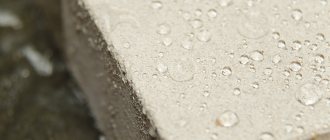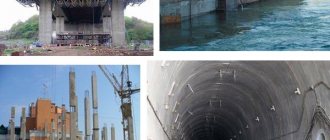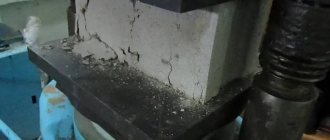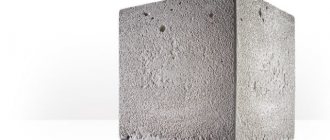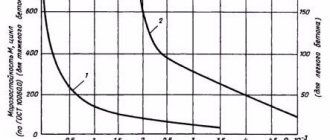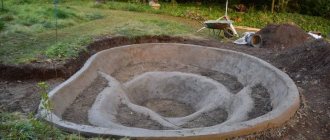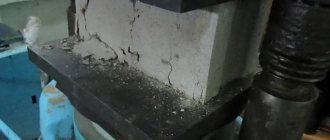The ability of artificial stone not to allow water to pass through under sufficient pressure is called the water resistance of concrete. Designated by the symbol W and within the even numbers from 2 to 20, indicating the pressure in MPa • 10 -1, the concrete elements of which with a height and diameter of 0.15 m hold the onslaught of water and do not allow it to pass through themselves.
Few people think that the use of concrete with high water resistance slightly increases the cost of construction, but can significantly reduce the cost of waterproofing the foundation. Depending on the type of object, it is worth analyzing what is cheaper, buying concrete with a high waterproof rating, or more expensive waterproofing.
Moisture resistance, classification
Water resistance is a parameter showing at what water pressure a material loses its ability to not absorb liquid or allow it to pass through itself.
The waterproofness of concrete means its resistance to water penetration. The characteristic is associated with frost resistance - the ability to withstand, without loss of properties, the freezing-thawing phase.
According to the Gosstandart system, provided for by GOST, construction norms and rules (SNiP), the waterproof grade of concrete is indicated by the graphic symbol W with numbers (from 2 to 20).
Marking of waterproof concrete
The water resistance of concrete, as you might guess, is its ability not to allow water to pass through under a certain pressure. As a rule, such material is used in the construction of all kinds of hydraulic structures, including water tanks. However, it should be noted that it comes in many different types and is intended for different purposes.
In particular, hydraulic concrete is primarily divided according to the degree of water resistance into:
- Underwater;
- Designed for permanent use in water;
- For operation in the zone of variable water horizon;
- Subject to occasional washing with water.
In addition, it is distinguished into the following types:
- Massive and non-massive;
- Designed for pressure and non-pressure structures.
To choose the right material, you need to understand its designations, which we will consider below.
In the photo - a hydraulic structure
Waterproof designation
As for water resistance, the material is divided into the following grades - W2, W4, W6, W20. The numbers indicate at what pressure it does not allow water to pass through. Thus, the water resistance of W6 concrete is 0.6 MPa.
Compressive strength
Another important indicator is compressive strength. This material parameter is determined at the age of 180 days. For construction, concrete classes B10, B40 are used. For example, class B10 corresponds to concrete grade M150, B20 to grade M250, and B30 to grade M400.
Frost resistance
Hydroconcrete is also divided according to the degree of frost resistance. There are five brands of it - F50, F100, F150, F200 and F300. In this case, the numbers indicate the number of freezing and thawing cycles, after which its strength will decrease by no more than 25 percent.
Advice! The frost resistance requirement applies only to those hydraulic materials that are exposed to the simultaneous effects of water and frost during operation. Since the price of the solution depends on this indicator, it does not always make sense to purchase it.
Now, having understood the features of marking, you can easily determine the characteristics of W6 concrete. This will allow you to select the most suitable material for use in certain conditions.
Methods and methods for determining resistance to liquids
To establish the level of water resistance, the resistance of concrete to liquid penetration, a number of methods are used.
The main ones include:
- “wet spot”, the highest pressure is calculated, at which the material does not allow liquid to pass through (requires mandatory testing);
- calculation of the filtration coefficient - a parameter that correlates pressure with the length of filtration time.
Auxiliary:
- appearance (inspection, study of structure);
- determination of the presence of additives, additives, coatings;
- establishing porosity, the number of pores per unit area; the fewer there are, the higher the moisture resistance index.
Porosity and Density
The concrete composition, being a porous-capillary body, is permeable to moisture during the presence of appropriate pressure. Water resistance depends significantly on the porosity of the material.
Causes of pores:
- reducing the volume of concrete when drying;
- the presence of an excessive amount of water in the solution;
- bad seal.
The required compaction of the solution is achieved through careful vibration and stirring of the cement composition.
The chemical reaction of concrete components with water, which takes place in the mass during strength gain, is called hydration. Moreover, the reaction lasts for a long time.
For complete hydration of cement particles, the volume of water must be at the level of 45% of the total mass of concrete, this corresponds to the water-cement ratio W/C = 0.45. Moreover, only 55% of the total amount of water in the solution is chemically bound, this corresponds to W/C = 0.20.
In theory, W/C = 0.20 is enough to hydrate concrete, but at the same time the hardness of the solution increases significantly, therefore in practice a concrete mixture with a W/C ratio of approximately 0.5 is used, this completely ensures convenient delivery and pouring of the solution.
Water that has not entered into the hydration reaction forms many pores in the mass after solidification. Some of which are closed, and some create through tunnels through which moisture subsequently begins to pass.
To improve water resistance, the amount of moisture during mixing must be minimized (W/C = 0.45 is the optimal value).
A reduction in the water-cement ratio (for example, from W/C = 0.6 to W/C = 0.45, i.e. by 25%) with a certain mobility of the cement composition is achieved through the use of plasticizers, and the number of pores is significantly reduced.
To obtain the most dense solution with a high level of water resistance, various waterproofing additives are used.
Factors affecting water resistance
The main determining factor influencing the resistance of concrete to moisture is porosity - the presence of open cavities (pores) in the structure. Their positive role is that they allow the building material to “breathe” and exchange water with the environment.
But the presence of pores is always associated with a loss of strength parameters.
The water resistance of concrete is also determined by:
- the density, the higher it is, the greater the water resistance coefficient;
- shrinkage, states - the material has low resistance to liquid penetration;
- an excess of grout due to a violation of the optimal cement/water ratio, leading to increased formation of pores;
- presence, absence, additives (additives) affecting the ability to withstand the destructive effects of moisture;
- brand of cement, on which the quality of the manufactured construction mixture depends;
- age parameters: as strength increases in the thickness of the material, the number of hydrate formations increases, which fill the pores, increasing water resistance;
- brand of concrete.
Note! To minimize voids at the manufacturing stage, the solution should be thoroughly mixed and vibration devices should be used when laying it.
If SNiPs are observed, the resistance of concrete to moisture is affected by “age”. Hydrophobicity indicators increase in the first half of the year, then the process of stabilization begins.
How to waterproof concrete mix
In order to increase the water resistance of a concrete mixture, it is recommended to use a large number of methods. When making the mixture with your own hands, it is recommended to eliminate the shrinkage of concrete, as well as provide a temporary effect on it.
Elimination of composition shrinkage
According to the properties of the material of medium grades, it contains pores in sufficient quantities. They promote the penetration of moisture into the material. This is explained by the fact that during the hardening process, gradual shrinkage of concrete is observed.
In order to reduce the degree of concrete shrinkage, it is recommended to follow certain rules:
- In order to increase the class of concrete, the use of special compounds is recommended. With their help, a special film is formed, with the help of which the possibility of shrinkage is limited. The addition of compounds must be carried out in strict accordance with the instructions, which will ensure excellent technical characteristics of the concrete mixture. Otherwise, the opposite effect will be diagnosed.
- After preparing the solution, it should be sprinkled with water every 4 hours. The procedure should be carried out no more than 4 days. After this time, the concrete should harden naturally.
- After pouring, the material should be covered with plastic film. This will provide the opportunity for the formation of slight condensation, which will prevent shrinkage of the concrete. During the manipulation, it is recommended to ensure that the film does not touch the concrete.
Temporary impact
In order to increase the water resistance of concrete, it is recommended to provide temporary exposure. The material must be kept dry for a long period, which will lead to improved technical characteristics. To promote a high filtration rate, the concrete mixture must be stored properly.
The material should be stored in a dark and warm place characterized by a high level of moisture. An increase in the quality of artificial stone several times is observed after 6 months of storage.
other methods
In order to create waterproof concrete with a solution of hydrophobic cement, it is recommended to apply coating materials to the surface. For this purpose, mastic or hot bitumen is used. Before applying to the surface, you need to clean the concrete structure and prime it. This ensures high-quality adhesion between coating materials and concrete. At the final stage, mastic or bitumen is applied in several layers. The thickness of one layer must be at least 2 millimeters. A few minutes after applying the composition, a protective crust forms on the surface.
This method has a certain disadvantage. When artificial stone is deformed, the coating layer is destroyed. If you choose the wrong mastic, the protective layer may drain.
In order to create a protective layer, it is recommended to use painted waterproofing, which improves the waterproof qualities of the concrete structure. The technique involves applying an emulsion, heated bitumen or mastic to the surface. After this, primer or paint is applied in several layers.
To increase the moisture resistance of concrete, it is recommended to use special additives, which are presented in a wide range on the modern construction market. The use of ferric chloride and silicate glue is recommended. The cheapest supplement option is calcium nitrate. It has excellent resistance to moisture. The product dissolves well in water, which simplifies the process of its use. To ensure a high level of moisture resistance, the use of sodium oleate is recommended. Thanks to all of the above additives, an increase in the indicator is ensured. The choice of supplement depends on the financial capabilities of the user.
Water resistance is an important indicator used to determine the quality of concrete. In accordance with this value, brands of artificial stone are provided. Not only the amount of moisture passed through, but also the amount of loads that the artificial stone can withstand depends on them. To increase the moisture resistance at home, it is recommended to use polyethylene film to cover the surface. Coating or paint materials can also be applied to concrete.
Characteristics of waterproof grades
When choosing the type of concrete, attention is usually paid to the grade (class) of water resistance. The scope of application of this building material depends on it.
Indicators for W2, W4, W6, W8 and W12
The water permeability of concrete is indicated by W with even numbers (from 2 to 20):
- W2 - indicators are low. The material is not waterproof; products must be provided with additional waterproofing measures.
- W4 - indicators are normal. Used for laying foundations in soils characterized by low humidity, with waterproofing at high humidity.
- W6 - has average stability indicators. Suitable for the construction of small structures.
- W8 - high stability. It is in demand during the construction of objects that have increased requirements for resistance to moisture.
Important! Grades W10 - W20 (highly resistant) are used for the construction of hydraulic structures, bunkers, reservoirs, and swimming pools. This is the optimal material for the foundations of multi-story buildings.
What additives are used to increase water resistance?
The waterproofing properties of concrete can be increased by using external waterproofing or by using special additives at the stage of preparing the concrete mixture. We will not consider external waterproofing; this is a topic for a separate article; now additives that can increase the waterproof rating are more important.
Today, the most common additives are hydrophobic ones. They increase water resistance and partially frost resistance, slightly increase density, which also affects strength, and slightly improve ductility. These additives can be either liquid or dry. But hydrophobic additives have their drawbacks:
- reduce the thermal insulation properties of concrete;
- they are not recommended for use during construction in winter;
- can affect the drying time of the concrete mixture;
- do not eliminate the problem of concrete shrinkage, which forces the use of additional additives.
However, more advanced additives have recently appeared on the market that not only improve water resistance, but also other characteristics of concrete. And this polypropylene fiber fiber is a universal reinforcing additive made from primary polymer, which creates a three-dimensional matrix structure in the concrete mixture, increasing all the characteristics of concrete.
The most popular brand of fiber is MicroArm (especially strong extruded polypropylene microfibers 2-18 mm long). In addition to increasing the main characteristics - tensile strength in bending, impact strength, preventing delamination of the concrete mixture, reducing the likelihood of cracks by 70% - MicroArm also significantly increases the water resistance, which, as expected, affects frost resistance.
According to the latest tests, the water resistance of a concrete sample with fiber fiber in its composition increased by 4 points, from W2 to W6. At the same time, frost resistance also increased from 30 MPa to 35 MPa. This suggests that even a small amount of fiber has a significant effect on both the standard performance of concrete and its water resistance. Fiber consumption per m3 is from 0.6 to 2.5 kg, depending on the purpose of the future structure. If you need waterproof concrete, it is not necessary to buy a higher grade of cement or use waterproofing additives, add fiber.
Polypropylene fiber is a modern reinforcing building additive with great potential. Today fiber is widely used in private and industrial construction. And in some areas of construction it is simply irreplaceable.
Ways to increase water resistance
The water resistance of concrete can be increased in various ways. The choice depends on the area where it will be applied:
- By introducing plasticizing additives when changing the water-cement ratio to obtain a more dense material.
- Using aluminous cement.
- Inclusion of aluminum and iron sulfates into the mixture.
- Adding additives and water repellents.
- Using coating compounds and impregnations.
Why concrete has different water resistance
Water resistance is affected by many factors. This ability is provided by the special capillary-porous structure of the material. Water resistance in dense concrete is much higher because it has fewer pores.
Low compaction composition , excess water and shrinkage can be the reasons for a large pore volume. During drying and hardening, shrinkage occurs and the volume of the concrete mixture decreases. The greatest shrinkage occurs from limited reinforcement and evaporation of water under the influence of negative environmental factors.
Air-entraining additives change the nature of porosity. Pores close and become denser.
Material based on alumina and high-strength cement composition has a higher level of water resistance. Such species attach more water molecules when hydrated and form a high-density stone.
The water resistance of concrete depends on the type of additives. The degree of compaction of the mixture increases due to aluminum and iron sulfates. This occurs through vibration, pressing and vacuum removal of water. Regarding pozzolanic Portland cement, its impressive impermeability rating is directly dependent on the volume of pozzolanic additions and their swelling.
The age of the concrete structure also affects performance. The older the cement, the more hydrate formations become, which is the reason for the increase in water resistance.
Concrete grades by frost resistance
If the building is operated in the middle and northern latitudes of Russia, the operational features are greatly influenced by the frost resistance of the material. This is nothing more than the ability of masonry to maintain its characteristics under conditions of alternating freezing and, conversely, thawing. Specialists pay great attention to this property when it is planned to erect bridge supports, construct hydraulic structures and equip airfield pavements.
READ ALSO: What are the types of cellular concrete and their characteristics
Frost resistance is determined by the letter F, it ranges from F25 to F1000. Whether this characteristic is important or not, builders decide based on climatic conditions, taking into account the cold season of the year. The most powerful and dense high-grade concretes remain the most frost-resistant.
What is the strength of concrete?
Strength indicators are fixed in compression; GOST establishes types of concrete from M50 to M800. Trains from M100 to M500 inclusive are recognized as especially popular. Their main difference is the density of the aggregates. The greater the load, the more powerful the material should be. The lightest mixtures M50, M75, M100 are rarely used - for the construction of blind areas. For railway structures or floor coverings, concrete grade M200 is used. The M550 is considered incredibly durable.
It is important to follow the production technology.
Unfortunately, concrete does not provide a perfectly flat surface, which is considered the best option for moisture protection: pores initially form on it. This happens for a number of reasons:
- Due to a reduction in the volume of cement mortar due to its drying (shrinkage), especially when there is an excess amount of liquid.
- If the mass is poorly compacted.
In this regard, the following conditions must be met:
- The water-cement ratio should correspond to a value of 0.4.
- There should be 2 times more gravel in the batch volume than sand.
- It is allowed to use only M300 and M400 cement (M200 as a last resort).
For the first 3 days, it is recommended to moisten the hardening surface after 3 hours and cover the structures on top with a protective film. But without the addition of special plasticizers that help prevent the formation of pores, the condition of the finished concrete may not reach the desired parameters.
There are also silicone water repellents used as a primer. They fill the pores by 10 cm or more, which blocks the access of water to the concrete body. Impregnation depth of up to 1 m is achieved using special penetrating waterproofing, for example, the Penetron category. In this case, the blockage of pores is facilitated by the lime present in the concrete.
Thus, industry experts note: increasing the level of water resistance is possible only with strict adherence to technology.
Science knows the main and auxiliary methods for measuring the level of water resistance.
- Filtration.
- "Wet spot."
The latter method, when the maximum pressure at which liquid does not penetrate inside is determined, is more common.
- Structural analysis. The degree of waterproofness of concrete is determined according to an inverse proportional relationship; when the number of pores decreases, the indicator increases.
- Characteristics of the binder - Portland cement and hydrophobic cement.
Advantages and disadvantages
Water absorbed by concrete negatively affects its operational properties and the operational characteristics of the premises in which structures made on its basis are used. In particular, water has the following effect:
- It increases the percentage of freezing of the mixture - the thermal conductivity characteristics are reduced, water filling the pores during freezing and expansion can cause cracking of the surface and lead to concrete crumbling. If contact with a liquid medium occurs constantly or very often, over time such elements and parts become unusable and require replacement or major repairs;
- Mold formation – a surface saturated with moisture is an optimal environment for the development and spread of mold and mildew. The presence of harmful microorganisms negatively affects the microclimate of the room, and also contributes to the destruction of finishing materials used to decorate the base.
However, W4 concrete also has an important advantage - it is cheaper than concrete with a low level of water absorption, which is due to the characteristics of its composition, namely, a relatively lower cement content and the use of inexpensive aggregate materials. Thus, you can save a lot by using the material in areas where there is no contact with moisture or a humid environment.


